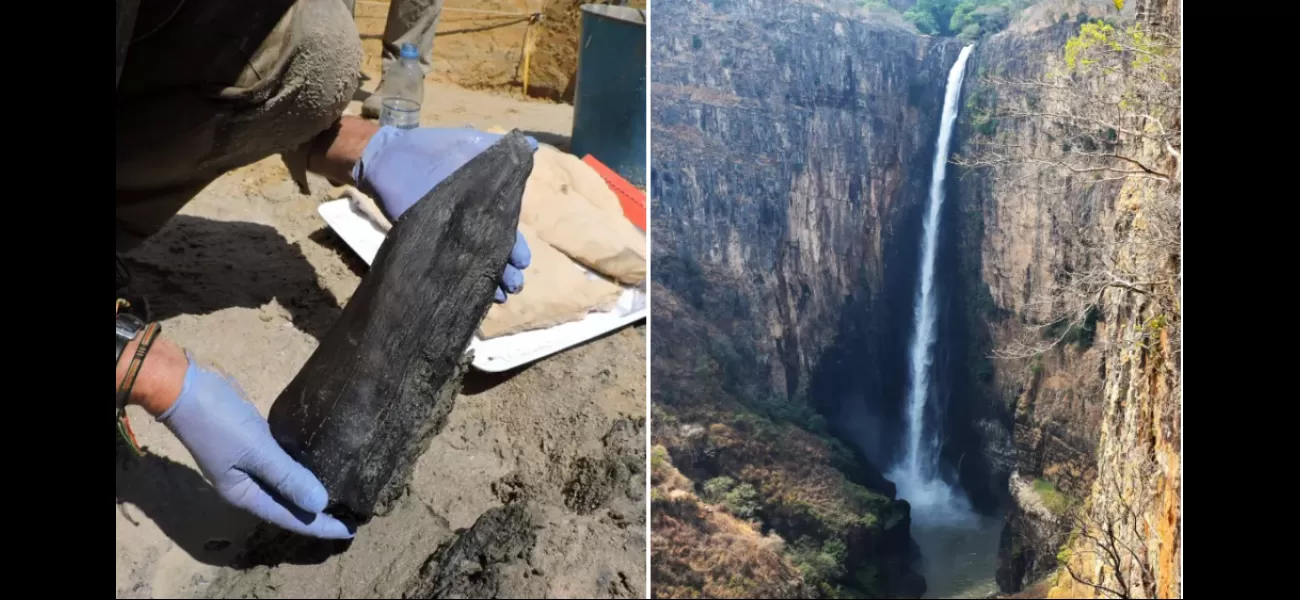Old wood shows our ancestors were more intelligent than believed.
They constructed before we evolved.
May 12th 2024.

Imagine standing at the edge of a majestic waterfall, surrounded by lush vegetation and the sound of rushing water. Now picture a wooden structure perched above the falls, a testament to the ingenuity and skill of our ancient ancestors. This discovery has completely transformed our understanding of the Stone Age.
Archaeologists have recently uncovered evidence of the world's oldest man-made wooden structures in Africa, dating back to the Early Stone Age. This finding suggests that our ancestors were far more advanced than we previously believed. The research team, made up of experts from the University of Liverpool and Aberystwyth University, carefully analyzed the well-preserved wood found at the archaeological site of Kalambo Falls in Zambia. To their surprise, the wood dates back at least 476,000 years, long before modern humans even existed.
The most remarkable aspect of this discovery is that it provides evidence of deliberate crafting of logs to fit together, a feat that was previously thought to be impossible at this point in human evolution. The team believes that the wooden structure was likely a platform or part of a dwelling, as evidenced by the expert analysis of stone tool cut-marks on the wood. This challenges the common belief that Stone Age humans were nomadic, as it shows that they had the ability to settle and create permanent structures.
The discovery of this wooden structure is particularly significant because wood is rarely found at such ancient sites. Typically, it rots and disappears over time. However, the permanently high water levels at Kalambo Falls have preserved this structure, allowing us to gain a deeper understanding of our ancestors' way of life.
The research team believes that the abundance of water and food sources at Kalambo Falls enabled our ancestors to not only survive but also thrive. This finding is part of the larger 'Deep Roots of Humanity' project, which aims to uncover how human technology developed during the Stone Age. Professor Larry Barham, the project's lead researcher from Liverpool University, expressed his amazement at this discovery, stating, "Forget the label 'Stone Age', look at what these people were doing - they made something new and large from wood. They used their intelligence, imagination, and skills to create something that had never previously existed."
The team also employed state-of-the-art dating techniques to determine the age of the wooden structure. Professor Geoff Duller from Aberystwyth University explains, "At this great age, putting a date on finds is very challenging, and we used luminescence dating to do this." This method allowed them to date the structure back further in time, providing valuable insight into human evolution.
The site of Kalambo Falls, situated on the Kalambo River at the border of Zambia and Tanzania, has been on UNESCO's tentative list for becoming a World Heritage site due to its archaeological significance. The recent discovery of the wooden structure adds even more weight to its potential inclusion. Professor Duller states, "Our research proves that this site is much older than previously thought, making its archaeological significance even greater. It's time for Kalambo Falls to become a United Nations World Heritage site."
Professor Barham echoes this sentiment, saying, "Kalambo Falls is an extraordinary site and a major heritage asset for Zambia. The Deep Roots team is looking forward to more exciting discoveries emerging from its waterlogged sands." This groundbreaking discovery has opened up a new realm of possibilities in our understanding of human evolution, and we can't wait to see what other secrets Kalambo Falls holds.
Archaeologists have recently uncovered evidence of the world's oldest man-made wooden structures in Africa, dating back to the Early Stone Age. This finding suggests that our ancestors were far more advanced than we previously believed. The research team, made up of experts from the University of Liverpool and Aberystwyth University, carefully analyzed the well-preserved wood found at the archaeological site of Kalambo Falls in Zambia. To their surprise, the wood dates back at least 476,000 years, long before modern humans even existed.
The most remarkable aspect of this discovery is that it provides evidence of deliberate crafting of logs to fit together, a feat that was previously thought to be impossible at this point in human evolution. The team believes that the wooden structure was likely a platform or part of a dwelling, as evidenced by the expert analysis of stone tool cut-marks on the wood. This challenges the common belief that Stone Age humans were nomadic, as it shows that they had the ability to settle and create permanent structures.
The discovery of this wooden structure is particularly significant because wood is rarely found at such ancient sites. Typically, it rots and disappears over time. However, the permanently high water levels at Kalambo Falls have preserved this structure, allowing us to gain a deeper understanding of our ancestors' way of life.
The research team believes that the abundance of water and food sources at Kalambo Falls enabled our ancestors to not only survive but also thrive. This finding is part of the larger 'Deep Roots of Humanity' project, which aims to uncover how human technology developed during the Stone Age. Professor Larry Barham, the project's lead researcher from Liverpool University, expressed his amazement at this discovery, stating, "Forget the label 'Stone Age', look at what these people were doing - they made something new and large from wood. They used their intelligence, imagination, and skills to create something that had never previously existed."
The team also employed state-of-the-art dating techniques to determine the age of the wooden structure. Professor Geoff Duller from Aberystwyth University explains, "At this great age, putting a date on finds is very challenging, and we used luminescence dating to do this." This method allowed them to date the structure back further in time, providing valuable insight into human evolution.
The site of Kalambo Falls, situated on the Kalambo River at the border of Zambia and Tanzania, has been on UNESCO's tentative list for becoming a World Heritage site due to its archaeological significance. The recent discovery of the wooden structure adds even more weight to its potential inclusion. Professor Duller states, "Our research proves that this site is much older than previously thought, making its archaeological significance even greater. It's time for Kalambo Falls to become a United Nations World Heritage site."
Professor Barham echoes this sentiment, saying, "Kalambo Falls is an extraordinary site and a major heritage asset for Zambia. The Deep Roots team is looking forward to more exciting discoveries emerging from its waterlogged sands." This groundbreaking discovery has opened up a new realm of possibilities in our understanding of human evolution, and we can't wait to see what other secrets Kalambo Falls holds.
[This article has been trending online recently and has been generated with AI. Your feed is customized.]
[Generative AI is experimental.]
0
0
Submit Comment





